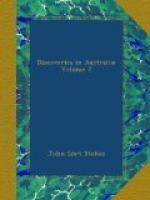Silk cotton-tree.
At Reach Hopeless, and at other points of the important stream I am describing we observed numerous specimens of a kind of silk cotton-tree (Bombax): the diameter was sometimes as great as twenty inches; and it not unfrequently rose to the height of twenty or thirty feet, though generally shorter. The pods were of an oval shape, and about two inches and a half in length; each pod was in three divisions and full of a silky cotton, with the seeds not imbedded but held at the extremity of the fibres. I brought home a specimen and presented it to Sir William Hooker, of the Royal Botanical Gardens at Kew, with whom I have since had some correspondence on the subject. He informs me that the plant is one hitherto undescribed; but that Sir Joseph Banks met with it in Captain Cook’s voyage.
November 17.
We continued our descent of the river: stopping from time to time to complete the survey. In the end of Long Reach we noticed that the stream ran up two hours after high-water. After securing some observations for latitude under Station Peak in the early part of the night, we proceeded further down the river, delighted to escape from that mosquito-haunted neighbourhood.
Effects of drinking salt-water.
November 18.
At day-break I was very much distressed and astonished to see one of the men on a sudden start up under the influence of delirium, and attempt to throw himself into the water, from which the combined strength of three or four of the crew with difficulty restrained him. He was one of the best men I had with me; his sudden and serious illness had doubtless been produced by the draughts of saltwater which he had swallowed during the night. He had been accustomed to indulge in very liberal potations while we were up the river, and now, when from necessity the allowance was restricted to a gallon per day, he had most foolishly attempted in the dark to quench his thirst with the salt waters of the advancing tide. In the afternoon we rejoined the ship, and he was placed under the care of Mr. Bynoe; but it was some time before he fully recovered from the effects of his rash experiment. The day was very oppressive, the thermometer being 105 degrees in the shade, and there was no wind. We were cordially greeted by our shipmates upon our return, and both Mr. Forsyth and myself enjoyed the luxury of a night’s rest in our hammocks; a most agreeable change after the hot stones upon which we had generally been compelled to court repose during our exploration. We had both suffered much inconvenience from the attacks of flies upon our visual organs, necessarily exposed and undefended as they had been when we were occupied during the observations and in viewing the strange scenes of the last eighteen days. The irritation upon the lids produced a copious discharge, which fairly sealed them up at night; so that, at last, in order to have them ready for immediate use, I found it requisite to sleep with a wet linen cloth covering each eye.




